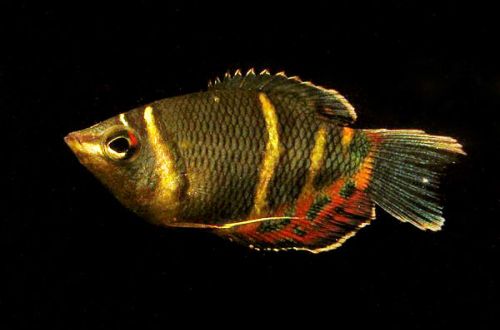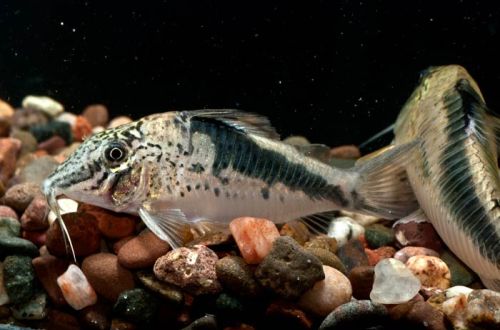
Chocolate Gourami
Chocolate gourami, scientific name Sphaerichthys osphromenoides, belongs to the Osphronemidae family. Beautiful peaceful fish, compatible with many species that can live in similar conditions. Easy to keep and breed. Parental instincts are well developed. Gourami takes care of future offspring, and the main role is played by the female, which is not typical for representatives of labyrinths.

Contents
Habitat
It comes from Southeast Asia, is widely distributed throughout Hindustan and the Maklaka Peninsula. It lives in peat bogs and related rivers, the water in which has acidic pH values and is colored in a rich brown hue from a high concentration of humic acids and other chemicals released during the decomposition of plant organic matter. The dense cover of the tropical forest practically does not allow sunlight to reach the surface of the water, and the bottom is littered with numerous branches, leaves and fruits of trees.
Brief information:
- The volume of the aquarium – from 50 liters.
- Temperature – 23-30°C
- Value pH — 4.0–6.5
- Water hardness – soft (1-5 dGH)
- Substrate type – any soft
- Lighting – subdued
- Brackish water – no
- Water movement – little or no
- The size of the fish is up to 5 cm.
- Food – any food
- Temperament – peaceful
- Content alone or in a group
Description
Adults reach a length of about 5 cm. The predominant color is brown with several light vertical stripes. Depending on the region of origin, red markings may be present on the fins. Sexual dimorphism is weakly expressed, there are practically no differences in color between the sexes.
Food
Accepts all types of dry, frozen and live foods of suitable size. To maintain the brightness of the color, it is recommended to combine several types of feed in the diet, for example, flakes in combination with bloodworms or brine shrimp.
Maintenance and care, maintenance of the aquarium
The size of the aquarium for one pair of fish starts from 50 liters. The design uses a soft substrate, dense clusters of rooting and floating shade-loving plants and numerous shelters in the form of snags or decorative objects (wrecks, castles, etc.).
Optimum housing conditions are achieved with acidic pH values, low carbonate hardness, low light levels and no internal flow. The equipment is selected in accordance with these conditions.
To simulate the water conditions of a natural habitat, a filter with peat-based filter material (lowers the pH value) and tree leaves that line the bottom can be used in an aquarium. In the process of decomposition, they saturate the water with humic acids and other chemicals, and also turn it light brown. The leaves are pre-dried and then soaked until they sink.
Maintenance of the aquarium comes down to regular cleaning of the soil from organic waste, weekly replacement of part of the water (10-15% of the volume) with fresh water and replacing the leaves, if present, once every two weeks.
Behavior and Compatibility
Peaceful calm look, content is allowed both singly and in a large group. Intraspecific conflicts have not been noticed, only small skirmishes are possible during the mating season, but they never lead to injuries and serve to establish a hierarchy.
The choice of neighbors should be pushed carefully, the Chocolate Gourami will not be able to compete with active schooling and / or large fish and, as a result, will be pushed aside from the feeders, become intimidated. Give preference to small species such as Rasboras.
Breeding / breeding
Differs in a strategy of reproduction, unique for labyrinth fishes. Usually, males build airy foamy nests near the surface, or collect eggs in their mouths, where they stay for the entire incubation period. In the Chocolate Gourami, the female takes all responsibility for the future offspring.
Under favorable conditions, spawning can begin at any time during the year. During the mating season, an increase in the color of females is noted, acquiring a rich chocolate color, and golden hues appear in light stripes. Courtship begins at the initiative of the alpha male, if the fish are kept in a group. The spawning process can take several hours. Immediately after spawning, she collects eggs and places them in her mouth, as males do in related species, and hide in a safe shelter. After 7-10 days, fry appear, their number rarely exceeds 30. To increase the chances of survival, it is advisable to transfer the fry to a separate tank with identical water conditions.
Fish diseases
The main cause of most diseases is unsuitable living conditions and poor-quality food. If the first symptoms are detected, you should check the water parameters and the presence of high concentrations of hazardous substances (ammonia, nitrites, nitrates, etc.), if necessary, bring the indicators back to normal and only then proceed with treatment. Read more about symptoms and treatments in the Aquarium Fish Diseases section.





